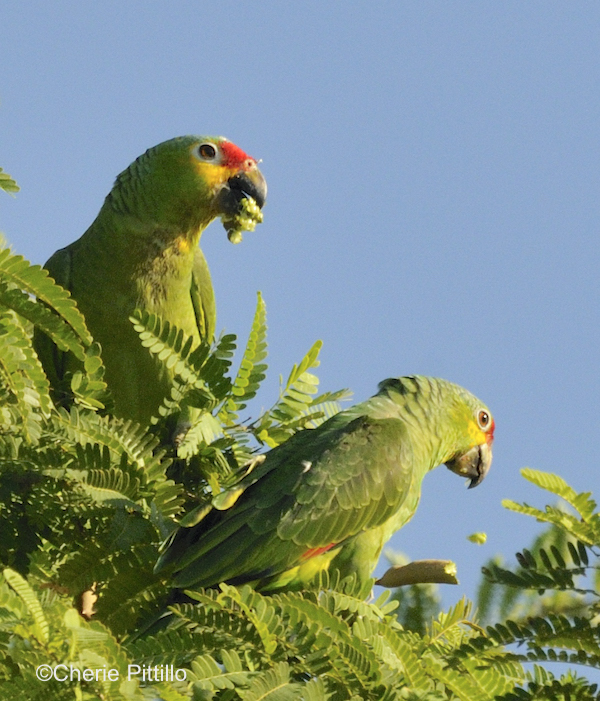Red-lored Parrots with dirty bills
Bird behavior fascinates me. I’m curious about how and then why birds act as they do. Often I see a variety of birds wipe their bills on their perches or nearby surfaces and assumed that behavior functions as a cleaner. Usually I notice a bird wipe its bill back and forth on opposite sides of a perch whether real or manmade like a clothes line or a fence wire or another limb.

My concentration on bill cleaning began at Eco-Parque, one of Merida’s city parks, where I watched two Green Herons slide their tongues on both sides of their bill. One had just eaten a small fish. It did occur to me that maybe the other one was just wiping off water.





And of course, I would think bathing would also clean the bill with this Northern Cardinal as an example.
So I decided to research an assumable easy topic in case my inferences weren’t complete. Once again, I was partly right, but what I uncovered surprised me even more. And I think this column will amaze you too!
Certainly sticky foods equate to messy bills as seen in the first image of the Red-lored Parrots dining on tamarind pulp and seeds or with another Red-lored Parrot feeding in the same tree.

But what I kinda knew but hadn’t really thought about was that bills continue to grow non-stop and contain keratin, the same protein in our fingernails. Bill-wiping is necessary to sharpen the bill. In healthy birds, eating and foraging typically keep the bills filed down to a constant length. However, some birds may also grind their beaks which can reduce that growth.
Studies indicate birds on smooth perches wipe their bills more than birds on rough perches. That makes sense! Also those with rough perches could pick up their food faster. Plus the mouth may or may not be open during the wiping process. But wiping actually impacts bill length and shape. Also scientists theorize wiping varies to make the bill more efficient with seasonal diet changes.
Alex, please make slide show of these 4 photos. You don’t need to add the captions, but I gave them to you to help identify each photo.
CAROLINA WREN WIPING ITS BILL SLIDE SHOW




For decades scientists observed bill wiping in social interactions and concluded those were merely displacement actions. But more recent studies disagree.
One study looked at the waxy substance from the preen gland at a bird’s rump to see if a bird wiped this oil on nearby surfaces to attract a mate. A bird can use its bill and/or neck to spread the preen oil to clean and maintain their feathers. Preen oil contains compounds that add odor to a bird and also offers chemical signals during courtship. (By the way birds do have a sense of smell which has taken decades for scientists to accept/admit that.) The study indicated bill-wiping worked well for males to attract a female but not a male.
Another study suggests the preen oil odor could help identify rivals. All that bill wiping on a branch could heat up the oil and release odors trapped in it. This could serve as scent-marking similar to how mammals leave olfactory signals to mark their territory. Wow, that was unexpected!
Plus another theory includes that the number of bill wipes could actually be signs of aggression towards other members of the same species along with head and body position that does indicate aggression.
But wait, there is more.
Since the bill has many blood vessels, it can impact thermal regulation. Its heat exchange with the environment can vary remarkably between 2-400%! But with that statement I’m introducing the science of biomechanics of the bill, which is more than I can understand and write in detail.
Plus I have one more theory about bill cleaning and it involves a White-fronted Parrot feeding on leaves and stems of the aforementioned tamarindo tree. Yes, parrots feed on vegetation too, but is it possible the stemmy leaves could act as a toothpick or toothbrush to also help clean the bill, inside and out, or in other avians?

In conclusion, what I can now infer is that bill cleaning in birds could serve as a cologne distributor, a honing device, a napkin, a mate attractant, a rival detector, or a territorial marker. Who knows what other studies will unveil about this remarkable behavior?
SPECIES LIST:
Red-lored Parrot, Amazon autumnalis, Loro Cachetes Amarillos(Spanish), Kocha’a (Mayan)
Yucatan Wren, Campylorhynchus yucatanicus, Matraca Yucateca (Spanish), X ya’an kotil o Chocuá (Mayan)
Green Heron, Butorides virescens, Garcia Verde (Spanish), Chuja (Mayan)
Northern Cardinal, Cardinalis cardinalis, Cardenal Rojo (Spanish), Chakts’iits’ib (Mayan)
Carolina (White-browed) Wren, Thryothorus ludovicianus (albinucha), Saltapared de Carolina (Spanish), Xya’an kotil (Mayan)
White-fronted Parrot, Amazona albifrons, Loro Frente Blanca (Spanish), Sao pool xt’uut (Mayan)
STAY FASCINATED ABOUT NATURE; YOU WON’T BE DISAPPOINTED!
DISCLAIMER: Some references may not agree or I may not have found the most recent name changes. Plus autocorrect doesn’t like scientific names or language translations.
Sal a Pajarear Yucatán (Guía de Aves),
https://onlinelibrary.wiley.com/doi/abs/10.1111/brv.12299
https://sora.unm.edu/sites/default/files/journals/wilson/v082n03/p0279-p0288.pdf
https://www.sciencedirect.com/science/article/abs/pii/S0003347205800764
Cherie Pittillo, “nature inspired,” photographer and author, explores nature everywhere she goes. She’s identified 56 bird species in her Merida, Yucatan backyard view. Her monthly column features anecdotes about birding in Merida, Yucatan and also wildlife beyond the Yucatan.
Contact: [email protected] All rights reserved, ©Cherie Pittillo

